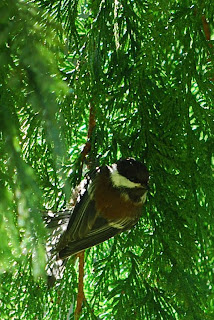First, there were the Goldfinches - a beautifully matched pair that are busier than usual these days. Hounding their every move, with fluttering wings and begging chirps, their three fledglings followed. They are old enough to feed themselves, of course, but then why give up a good thing? Must have been graduation day as the parents commandeered both perches at the seed feeder and fed themselves, ignoring their complaining offspring.
Next, lively chattering, came the mother Downy Woodpecker and her little one, who also is old enough to take care of itself and busily dove into the hanging suet. Already its agility nearly matches that of the parent, for the swinging feeder poses no problem for it. Reluctantly, they give up their places to a noisy group of Nuthatches and Chickadees that are all atwitter with boundless energy. Their antics always make me smile as they flit back and forth between feeder and branch, quickly changing places. There an understanding of sorts among them - each gets a turn, although it must not take too long or it will be nudged out of line. The Hairy Woodpecker arrives, scattering the smaller birds with loud cry and brusque attitude. It grabs its turn at the suet with no negotiation whatsoever. But even he leaves with the noisy arrival of the Starling, a bird none of the others want to associate with. Me neither, as I consider them real pests, so I tap on the window to drive it away. Before long, others arrive - the Grosbeaks, Pine Siskins, a Fox Sparrow or two, a family of House Finches. Then, during a lull in the action, it quietly sneaked in and once more I was enthralled.One small chickadee hungrily attacked the suet, but its methods were a bit different. Instead of grasping the hanging wire basket with its feet and dangling on the underside for easiest access, it fluttered its wings madly - like a hummingbird - just under the basket, repeatedly stabbing its beak in for a bite. Then it would rest on a nearby branch before repeating its performance. It exhausted me just watching him. Why on earth would this bird choose this method, when it obviously required a huge amount of energy to hover as it did? This little guy is also a regular so I was familiar with, and greatly intrigued by, its actions. Because birds burn up so much energy, they require a lot and seldom waste any. Yet, here was this one fluttering away for all it was worth.
Days of patient study finally revealed the reason - it has only one leg. Poking out stiffly to the rear, its crippled leg is of no use to it. This amazingly strong little bird has adjusted and adapted as well as it can to its disability. It is cautious, coming to the window feeders only when no others are there. It perches well on its one leg, so manages the small branch and seed feeder just fine. Landing on and hanging from the suet feeder was difficult for it, but lately it seems to have conquered even this skill, and flutters below only rarely now. I do not know how long it will survive - life is difficult and short even for healthy birds. But I do know that it has grit and a will to survive - and a joyful lilt in its voice and movement. It will not easily be forgotten.
“...Are not five sparrows sold for two pennies? Yet not one of them is forgotten by God. Indeed, the very hairs of your head are all numbered. Don’t be afraid; you are worth more than many sparrows....”
Luke 12: 6-7
Shout for joy, O heavens;
rejoice, O earth;
burst into song, O mountains!
For the LORD comforts his people
and will have compassion on his afflicted ones.
Isaiah 49:13






No comments:
Post a Comment